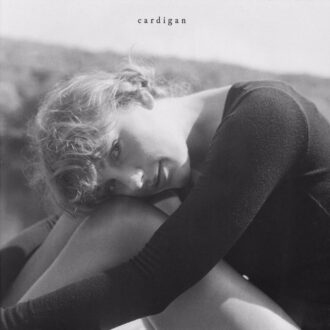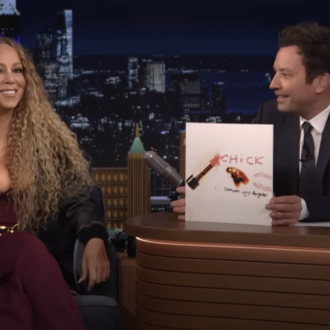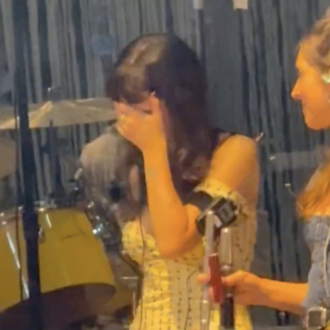Joni Mitchell, Jazz Artist?

Marcy Gensic
Is Joni Mitchell a jazz artist? Short answer: No. Long answer: No, but…
Nevertheless, there’s a new box set, 61 tracks and just under five hours long, called Joni’s Jazz that pulls tracks from 1968’s Song To A Seagull all the way up to 2023’s At Newport, recorded at the Newport Jazz Festival. The cover features a photo of Mitchell with Herbie Hancock and Wayne Shorter, and both men are featured extensively. Did you know Shorter played on 10 of Mitchell’s albums? I didn’t until I watched the two-part Amazon documentary about him.
Other jazz musicians heard on the set include saxophonists Michael Brecker and Tom Scott; flugelhornist Kenny Wheeler; keyboardist Joe Sample; guitarists Larry Carlton, Lionel Loueke, and Pat Metheny; bassists Dave Holland and Jaco Pastorius; and drummers Brian Blade, Vinnie Colaiuta, Peter Erskine, and John Guerin. And that’s without even bringing up her 1979 album Mingus, a collaboration with the legendary bassist/composer (ill with motor neuron disease, he didn’t perform).
Here is where I admit that I have never explored Joni Mitchell’s catalog in any depth. The only album of hers I’ve heard front to back is Blue, which is an astonishing record but has no jazz elements at all. Listening to this box — which Mitchell assembled herself, and which is dedicated to Shorter — I get a very clear picture of an artist who understands jazz, hears what jazz musicians can do for her songs, and collaborates with them in that spirit.
The liner notes include quotes from a 2013 interview with Shorter, who describes their collaboration, saying, “It mostly worked like, when we did a take, one take or something like that, we’d do another one, and then she would say, ‘Do you have any more of that?’ And then we’d do another take, something like that. ‘You got any more in you?’… It was always like whatever happens, happen. She knew I was not the kind of person you could ask, ‘Can you play something this way? Can you do it this way?’ Uh-uh. None of that.”
Similarly, Hancock, who was invited to the Mingus sessions by Pastorius, recalls, “I was thinking I might have to back off of certain things I might have done if it was just Jaco and Wayne, who were already doing cutting-edge stuff in jazz. But Joni actually said, ‘No, no. You go ahead and paint pictures, do whatever you want to do with the music.’ Then when she started to sing along with us, she fit in so easily, I was shocked.”
Although there are tracks from earlier releases here, the common narrative is that Mitchell’s jazz-influenced material begins with 1974’s Court And Spark, on which she employed members of Tom Scott’s band the L.A. Express. Drummer John Guerin was featured on that record and the three after it (The Hissing Of Summer Lawns, Hejira, and Don Juan’s Reckless Daughter); he and Mitchell were also a couple in that era. In a 1976 interview, he says, “When she started Court And Spark, she needed more sophisticated jazz players to handle the musical part. She needed the broad musical background that jazz musicians are capable of today. I feel being a jazz musician makes me more open.” But he adds, “I use the term ‘jazz’ for the want of a better label. Jazz doesn’t mean what it used to mean years ago.”
In her 2024 book Traveling: On The Path Of Joni Mitchell, critic Ann Powers addresses this aspect of Mitchell’s work at length. She quotes Mitchell telling L.A. Times critic Robert Hilburn in 2008, “Some people thought I was trying to do jazz and not quite getting it, but I wasn’t. The only thing I have in common with jazz is sometimes experimental rhythms, and these wide harmonies that are outside the rules of jazz.” But Powers ultimately comes around to filing Mitchell’s 1970s albums under the heading of fusion, which she describes as “not quite jazz, not quite rock, not quite funk, not able to elude any of these categories and become something totally new.”
I agree with this 100%. I’ve been thinking for years about fusion as a zone that encompasses much more than the artists most commonly identified with it: Miles Davis, Weather Report, Mahavishnu Orchestra, Return To Forever, et al. To me, the jazz orchestrations on their glorious 1970s albums make Earth, Wind & Fire a fusion act. Santana’s mix of spiritual trance-jazz, explosive Latin percussion and amp-frying guitar solos? Fusion. Donald Byrd and Freddie Hubbard’s high-flying trumpet solos, laid over lush proto-disco rhythms? Fusion. The Fania All Stars jamming in the studio with keyboardist Jan Hammer and drummer Billy Cobham of Mahavishnu Orchestra, and bringing guitarist Jorge Santana and African saxophonist Manu Dibango onstage at Yankee Stadium? Fusion for sure.
Powers takes this line of thinking even farther than I had; her list of “the Black pop elites who belong in the history of jazz fusion if we put Joni there, too” includes Bill Withers, Valerie Simpson, Gil Scott-Heron, Earth, Wind & Fire, Isaac Hayes, Charles Wright & the Watts 103rd Street Rhythm Band, post-Supremes Diana Ross, post–Muscle Shoals Aretha Franklin, Curtis Mayfield, Labi Siffre, Patrice Rushen, the Persuaders, the Sylvers, the Spinners, the Main Ingredient, Tower Of Power, War, and Roberta Flack. And there are many more names that could be added. (If I’m not careful, this might become the subject of my next book.)
One track in particular struck me as a near-perfect example of Mitchell as fusion artist: “Paprika Plains,” from Don Juan’s Reckless Daughter, which is tucked into the middle of the third disc here. First of all, it’s 16 minutes long. She’s playing piano solo for the first two minutes or so, before an orchestra conducted by Michael Gibbs rises up behind her, interacting beautifully with her vocal and pianistic melodies — subtly at first, then with huge swirls of color. It’s not until the final three minutes of the piece that the rhythm section arrives: Jaco Pastorius on bass, Guerin on drums, and — in a way that reminds me of Steely Dan’s “Aja,” on which he also performed — a major solo from Wayne Shorter. It’s a genuine epic, something I wasn’t expecting at all.
Also, check out this 1979 concert — released as Shadows And Light — with Michael Brecker on saxophone, Pat Metheny on guitar, Lyle Mays on keyboards, Jaco Pastorius on bass, and Don Alias on drums:
Still, since I came to Joni’s Jazz almost entirely unfamiliar with her work, I thought I should get some additional perspectives on what she was doing. I reached out to two friends and Mitchell fans, bassist/composer Linda May Han Oh and singer-songwriter John Darnielle of the Mountain Goats, for their thoughts.
I asked each of them if they thought of Mitchell as a jazz artist, or as a singer-songwriter working with jazz musicians, or something in between. Oh said simply, “Something in-between, but I don’t think it really matters.”
Darnielle’s response was deeper, but aligned. He said, “I don’t think of Mitchell’s music as jazz, no; she is a singer-songwriter, that’s a specific category. But there are a lot of ways to do it. There’s folk singer-songwriters and there’s rock singer-songwriters and there are electronic singer-songwriters (Neil Tennant probably the most obvious example here), and other genres; Michael Franks is kind of a smooth jazz singer-songwriter, if you buy ‘smooth jazz’ as a genre and not a marketing category.” He compared her with Bob Dylan as the two major figures coming out of folk music, but where Dylan embraced rock, Mitchell embraced jazz: “she lets jazz transform her craft, she’s completely open to it.”
He ended up in the same area as Oh, though, saying, “I don’t think it matters at all what we call it unless we enjoy categorizing as a sort of armchair game — I think most of the musicians who’ve worked with her are in the ‘it’s all just music’ realm of thought about this, which I think is the right realm. Either a person is a player or isn’t. Mitchell’s ensembles in this period are all players, and she’s one, too.”
I also wanted to know what made her music jazz or jazzy; was it the chords, the timbres, the rhythms? As a non-musician, what should I be listening for?
Oh said, “Joni’s melodies are quite unique and distinct. They can often be elaborate and winding in a way that really emphasizes her profound poetry. Perhaps part of the parallel with jazz-informed music is that sometimes melodies within jazz can be quite elaborate and winding. Additionally, I love the use of harmony and key changes within her music; many of my favorite jazz compositions move through multiple tonalities. Even in her song ‘The Fiddle And The Drum’ [from 1969’s Clouds; not included on Joni’s Jazz], Joni is only singing one line a cappella with no accompaniment, but nevertheless the song moves through a few keys and tonalities with a sense of clarity, due to the strength of the single melody.”
Finally, I wanted to know what impressed them the most about the way she worked with the jazz musicians she used on her records. What did she bring out of them? What did they give her?
Oh said, “Part of what is special to me about Joni’s music and musicianship is her openness and appreciation for experimentation with the musicians who worked with her. Musicians such as Jaco Pastorius, Wayne Shorter, Herbie Hancock, and Pat Metheny have brought exciting richness to her music. Often you can hear an open dialogue within the songs between the musicians and Joni. My favorite examples of that include the Shadows And Light album and the Mingus album.”
Darnielle added, “I think Mitchell’s melodies take wing when she gets the right players; I think she could write all these songs all by herself but I also suspect she enjoys showing how good she is to players who are able to appreciate it, and elevates her practice when she’s in that company.” He added, “I think most jazz musicians, when asked to play on a date, are mainly asking whether the gig is a good time and who they’ll be playing with; musicians play music, they generally prefer to play with people who can play on their level, I think it’s fair to say. It takes one listen to ‘Both Sides Now’ for any musician to say, wow, that’s one of those tunes with legs, not just anybody can write like that; and by the time Wayne Shorter gets a phone call, she’s done not only Blue (not jazz, but a masterpiece by any standard), but For The Roses, Court And Spark…Shorter loves knotty, look-at-’em-sideways melodies, he can hear where the spaces are in the music, and she’s already shown her facility by then. I’d guess he thought, ‘my practice and hers are similar in different genres, I’d have something to say in this musical context.'”
Joni’s Jazz is a very wide-ranging box; it includes not only her own compositions played by all the musicians discussed above and more, but also her versions of jazz tunes like “Comes Love,” “You’re My Thrill,” “Sometimes I’m Happy,” “Summertime,” “Stormy Weather,” and Annie Ross’s “Twisted,” and a pretty amazing version of Marvin Gaye’s “Trouble Man” backed by a big band led by, of all people, Kyle Eastwood (Clint’s bass-playing son). If you’re new to her work, as I was, or just want to consider it from a potentially new angle, it’s a great starting point.
TAKE 10
Donny McCaslin - "Celestial"
Saxophonist Donny McCaslin had a long and impressive career before he and his quartet were recruited by David Bowie for the singer’s final album, Blackstar, but that collaboration pushed his music down one particular path that he hasn’t abandoned yet. In the 1990s and early 2000s, McCaslin played in all kinds of contexts, from acoustic quartets to fusion-y ensembles to big bands, and was a technically skilled craftsman in the mold of Michael Brecker. Post-Bowie, he’s transformed into a jazz-rock hybrid player who writes big, riffy compositions. If he were active in the early ’60s he’d be closer to King Curtis than John Coltrane. “Celestial,” the first single from his latest album, starts off in a New Age/vaporwave zone, with keening sax over rippling keyboards, before the drums come in and he starts chewing on a single phrase over and over. It’s a nice, subtly hypnotic piece of jazzy trance-rock. (From Lullaby For The Lost, out 9/26 via Edition.)
Nils Petter Molvær - "Song Of Sand"
Norwegian trumpeter Nils Petter Molvær’s Khmer, released on ECM in 1998, was a pathbreaking album that combined jazz with electronic music in a genuinely fascinating and new way. He’s continued exploring similar territory ever since. Khmer Live In Bergen isn’t exactly what its title implies: it’s a live recording from 2023, but it only features versions of a few Khmer cuts: “Song Of Sand,” “Tløn,” and “Platonic Years.” A lot of the other pieces, like “Kakonita,” “Vilderness,” and “Solid Ether,” come from his next album, 2000’s Solid Ether. Two of the musicians who played on Khmer, guitarist Eivind Aarset and drummer Rune Arnesen, are present here, along with DJ/programmer Pål Nyhus, bassist Audun Erlien, and second drummer Per Lindvall. Together they create a kind of hazy, occasionally quite aggressive — check out Aarset’s guitar solo on “Song Of Sand” — electro-jazz-funk with the horn fed through a pleasingly disorienting array of effects. (From Khmer Live In Bergen, out now via Edition.)
Johnathan Blake - "Last Breath"
The music on drummer Johnathan Blake’s latest album is a 52-minute suite, originally commissioned and premiered by the Jazz Gallery. That room’s artistic director, Rio Sakairi, came up with many of the actual track titles, though she and Blake were firmly in tune on the overall concept. It’s a meditation on tragedy and injustice, but it’s also a call to action, reminding the listener of their obligation to help and do right. The band features Dayna Stephens on saxophone and EWI, Fabian Almazan on piano, Jalen Baker on vibes, and Dezron Douglas on bass, with DJ Jahi Sundance and vocalist Bilal turning up here and there. “Last Breath,” the first full piece following an intro track, begins with a few seconds of solo vibes before the rhythm section comes in, with Stephens’ EWI sounding more like a synth than a horn. It’s an eerie instrument I don’t always love, but it works here. (From My Life Matters, out now via Blue Note.)
George Coleman - "Ugly Beauty"
George Coleman is far too little known. Although he was well regarded within the jazz scene in the 1950s and 1960s — he worked with Max Roach, then joined Miles Davis’s quintet before Wayne Shorter took over — he’s spent the last half century doing his own thing, quietly making sharp acoustic jazz records year after year and playing brilliantly in clubs to small but devoted audiences. I saw him almost a decade ago and still remember the exhilaration of hearing him and special guest alto saxophonist Charles McPherson tear into bebop chestnuts. Amazingly, this is his first album with strings. The core band includes pianist David Hazeltine, bassist John Webber, and drummer Joe Farnsworth, with percussionist Café Da Silva guesting on a few tracks, and a 10-piece string section playing arrangements by Bill Dobbins. This extended version of Thelonious Monk’s “Ugly Beauty” lets the strings take the spotlight; it’s beautiful stuff. (From With Strings, out now via HighNote.)
Gary Bartz & NTU Troop - "You Are My Starship"
Alto saxophonist Gary Bartz has never been one to respect genre borders. He’s kind of a jazz heretic in some ways, most notably in his hatred for the sacred word “improvisation.” In a 2021 interview, he explained his perspective: “We’re composing, all the time. Improvising means you’re guessing, [but after] a lifetime of study, you’re not guessing — the only time I improvise is when I make a mistake. Each solo I have a plan.” His latest album is a collection of versions of R&B and pop tunes he likes, including “You Are My Starship,” originally recorded by drummer/producer Norman Connors with vocals by Michael Henderson — yes, the same Michael Henderson who played bass with Miles Davis from 1970 to 1975. This version features Barney McAll on keyboards, Kassa Overall on drums, and Brandee Younger on Harp, with vocals by McAll, Daniel Merriweather and Rita Satch. It’s smooth, but hot, too. (From Damage Control, out now via OYO.)
Gard Nilssen's Acoustic Unity - "Telemark Twist"
Since forming a decade ago, drummer Gard Nilssen’s Acoustic Unity has mostly been a trio, with André Roligheten on saxes and Petter Eldh on bass. They’ve occasionally brought guests to the party: on 2017’s 3CD Live In Europe, fellow saxophonists Kristoffer Berre Alberts, Fredrik Ljungkvist, and Jørgen Mathisen all showed up. But Great Intentions, the group’s fourth studio album and sixth release overall, is something new — they’ve expanded to a quintet with the addition of alto saxophonist Signe Emmeluth and Kjetil Møster on tenor and baritone. (Roligheten plays tenor, soprano, and bass, giving the band a range of horn sounds worthy of the Art Ensemble of Chicago.) “Telemark Twist” opens with a three-horn unison melody reminiscent of the World Saxophone Quartet, before the rhythm section kicks in and the baritone sax becomes a kind of second bass. The piece leaps and cavorts, recalling Ornette and Mingus in equal measure. (From Great Intentions, out now via Action Jazz.)
Fieldwork - "Embracing Difference"
Fieldwork is a collective trio originally formed by pianist Vijay Iyer, saxophonist Aaron Stewart, and drummer Elliot Humberto Kavee. Their first album, Your Life Flashes, came out in 2002. In 2005, they released Simulated Progress, with Steve Lehman in place of Stewart. On 2008’s Door, Tyshawn Sorey replaced Kavee. Now, 17 years later, the Iyer/Lehman/Sorey version is back again with Thereupon. There’s a weird nostalgic feel to this music. The 2000s were a very specific time in New York jazz. A collective compositional voice, heavily indebted to composers like Henry Threadgill, Roscoe Mitchell, Tim Berne, and Steve Coleman, was emerging, and all the various Fieldwork members were helping define that style and sound. They’ve each gone in any number of directions since, together and separately, but they slip back into those dynamics like pulling on an old pair of running shoes. “Embracing Difference” is a hard-charging, joyous fraternal reunion. (From Thereupon, out now via Pi Recordings.)
Mulatu Astatke - "Nètsanèt"
Ethiopian pianist and vibraphonist Mulatu Astatke invented a whole genre. There would be no such thing as “Ethio-jazz” had he not come to the US, become enraptured by jazz and Latin music, and introduced vibraphone and congas to traditional Ethiopian music. Throughout the 1960s and 1970s, he recorded albums — most notably 1972’s Mulatu Of Ethiopia — which were rediscovered decades later by crate-diggers. Now he’s winding down a career that’s spanned more than half a century, and on this album is revisiting old compositions with a large band that includes sax and trumpet, piano, cello, two bassists, drums and percussion, and multiple Ethiopian instruments. The group includes some notable UK avant-gardists like pianist Alexander Hawkins and bassist John Edwards, but they lock into the complex, shifting grooves of pieces like “Nètsanèt” with ease, creating a trancelike form of African jazz with Astatke’s vibes, occasional piano, and Wurlitzer at the center. (From Mulatu Plays Mulatu, out 9/26 via Strut.)
Dave Douglas - "Fields"
Trumpeter Dave Douglas’ newest album is a fascinating blend of post-bop and what I can only describe as a horn choir. He’s joined up front by two other trumpet players, Alexandra Ridout and David Adewumi, with a rhythm section composed of vibraphonist Patricia Brennan, bassist Kate Pass, and drummer Rudy Royston. This instrumentation allows for the creation of a particularly cloudlike, amorphous music. Royston is a sharp, aggressive drummer, but when he focuses on accents and interjections, as he does on “Fields,” he allows the horns to shiver in place like a mirage. The vibes, which Brennan mostly plays without the electronics she sometimes deploys as a disorientation strategy, are a different kind of shimmer, and she doesn’t support the horns, merely stands back waiting, and when she comes in, they fall into line behind her, then embark on a three-way conversation in which all voices become one. (From Alloy, out now via Greenleaf Music.)
Henry Threadgill - "R"
Henry Threadgill has always been a composer. But because he’s been classified as a jazz musician, that’s been overlooked. As he writes in his brilliant autobiography Easily Slip Into Another World, “There’s a tendency to underestimate the intellectual component in Black music across the board, as though we don’t possess a sophisticated understanding of what we’re doing. We’re just playing.” He describes even the music of his first group, Air, as “largely composed…music that is almost entirely written. Ninety percent of it is represented on paper in some form, including the sections that might sound like individual solos.”
In recent years, Threadgill has stepped back from performing with his ensembles and is now serving as composer and conductor. His 2018 album Double Up, Plays Double Up Plus featured an octet composed of two saxophonists, a cellist, a tuba player, three pianists and a drummer. On 2023’s The Other One, he assembled a 12-member ensemble with three saxophones, four string players, two bassoons, piano, tuba, and percussion to perform a three-movement, hour-long composition.
Threadgill’s long been interested in unorthodox combinations of instruments, frequently deployed in pairs or groups, going back to the four reeds and four basses of his first album as a leader, 1979’s X-75, Volume I. But he also composes for specific instrumentalists, in the manner of Duke Ellington; in Easily Slip, he writes, “I wanted to find my own group: a band I could write for,” and he’s done it over and over, forming bands like the Sextett, Very Very Circus, Make A Move, and Zooid, every one a tight group with members chosen for their personal voices.
His latest release, Listen Ship, takes his interest in banks of instruments to a new extreme. In some ways it picks up where “Noisy Flowers” and “The Mockingbird Sin” from his 1995 album Makin’ A Move left off; the first of those was arranged for four guitars and piano, the second for four guitars and three cellos. Listen Ship features four acoustic guitars, two acoustic bass guitars, and two pianos, playing a 44-minute piece divided into 16 tracks.
Throughout the piece, the guitars and pianos are doing entirely different things. The guitars and bass guitars are picked with quick, jagged force, sometimes reminiscent of gypsy jazz. The pianos come in when the guitars fall silent, playing melancholy, almost haunted figures that sound half the speed of what came before. It’s not until the second half of the piece, beginning with the eighth track, “H,” that the two instruments are heard together. And even then, they seem wary of each other, like two different species of animals showing up at the same watering hole. “R,” the track streaming here, is the piece’s longest segment and its conclusion, the point where it all comes together, the two pianos shadowed by the basses and the guitars circling, offering embellishment and commentary. This is a beautiful, if occasionally stark piece, one that ensembles around the world could do a lot with. (From Listen Ship, out now via Pi Recordings.)



